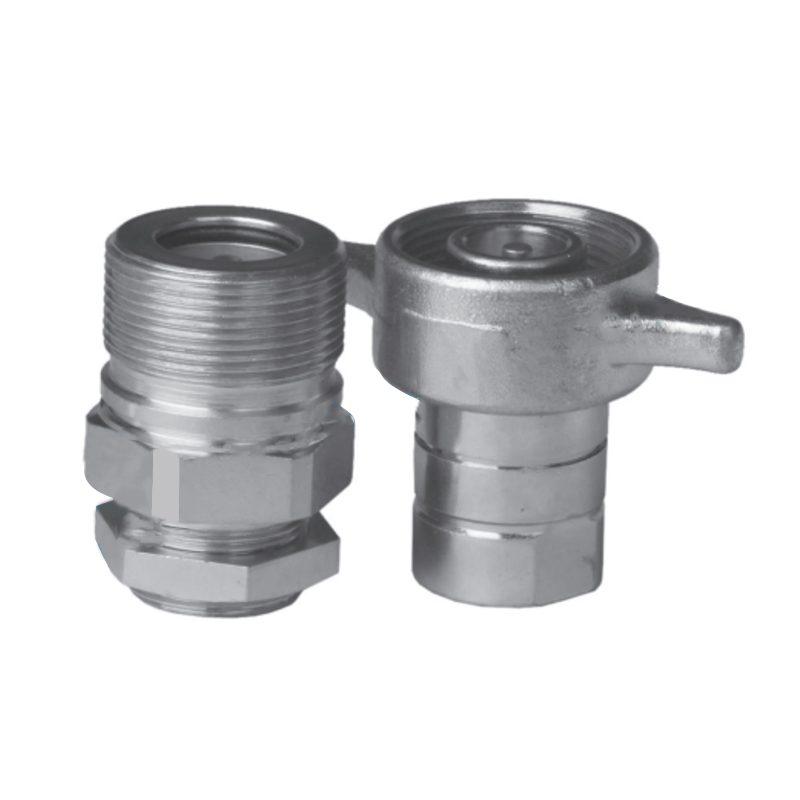Call us
+86-13732136622
+86-15058221666

Hydraulic quick couplers are designed to provide a convenient method for connecting and disconnecting hydraulic lines without the need for tools. However, their internal configuration can introduce flow restrictions. This is due to factors such as the diameter of the coupler passages, internal valving mechanisms, and the presence of seals. The degree of restriction varies depending on the coupler's design and intended application. While some quick couplers are engineered with features to minimize flow loss, all couplers will inherently restrict flow to some extent. This can impact the overall efficiency of the hydraulic system, especially in applications requiring high flow rates.
As hydraulic fluid flows through a quick coupler, a pressure drop occurs due to friction and turbulence within the coupler's internal pathways. This pressure drop is influenced by factors such as the coupler's design, the velocity of the fluid, and the fluid's viscosity. In systems operating at high pressures, even a small pressure drop can have significant effects on performance and efficiency. Selecting couplers with low-pressure drop characteristics can help mitigate this issue and maintain the desired operational pressures within the hydraulic system.
One of the critical functions of hydraulic quick couplers is to create a secure and leak-proof connection. However, over time, wear and tear, as well as improper sealing during connection or disconnection, can lead to leakage. Such leaks result in a loss of hydraulic fluid, which can reduce system pressure and impact overall performance. To prevent leakage, it is essential to regularly inspect and maintain couplers, ensuring that seals and connectors are in good condition and properly aligned.
The compatibility of hydraulic quick couplers with the hydraulic system's components is crucial for maintaining optimal flow rates and pressures. Using a coupler that does not match the system's specifications can result in excessive pressure drops, reduced flow rates, and potential system inefficiencies. Ensuring that the coupler's size, pressure rating, and flow capacity are suitable for the application is vital for achieving the desired performance and avoiding operational issues.
Hydraulic quick couplers are subjected to varying temperatures in operational environments. Elevated temperatures can cause materials used in the coupler, such as seals and metal components, to expand. This expansion may affect the coupler’s sealing performance and flow characteristics. Conversely, low temperatures can cause materials to become more brittle, potentially impacting the coupler's integrity and functionality. Selecting couplers designed to withstand specific temperature ranges and conducting regular inspections can help manage these effects and maintain system reliability.
Regular maintenance of hydraulic quick couplers is essential for ensuring their proper operation and longevity. Maintenance activities include cleaning, inspecting for signs of wear or damage, and replacing worn components as necessary. Proper maintenance helps prevent issues such as increased pressure drops, flow restrictions, and leakage. Implementing a routine maintenance schedule and adhering to manufacturer guidelines for care and inspection are key practices for sustaining optimal system performance.
GT-L3 Manual wing nut thread type hydraulic quick coupling

The GT-L3 is a type of hydraulic quick coupling that is designed for manual operation. It features a wing nut thread type connection that allows for easy and quick attachment and detachment of hydraulic hoses and lines.

The KZD steel internal thread medium pressure gas-liquid quick connector is a type of coupling designed to quickly and easily connect or disconnect th...
See Details
The GT-L3 is a type of hydraulic quick coupling that is designed for manual operation. It features a wing nut thread type connection that allows for e...
See Details
● Positive valve stop, the perch maintains valve alignment and provides metal to metal valve stop to ensure that the valves openfully, every time. ● P...
See Details
● Poppet valves available to prevent uncoupled leakage. ● Poppet valves open automatically when coupled, within . rated working pressure, to keep the...
See Details
Material: Carbon Steel Plating: Chrome Plated Temperature Range (Nbr): -20°C + 100°C Thread Size: Dn10 Dn12.5 Dn20 Dn25 Dn31.5 Thread: M18*1.5 M22*1....
See Details
The GT-200T manual single shut-off pneumatic quick coupling is a type of coupler used in pneumatic systems to quickly and easily connect and disconnec...
See Details
GT-MC Brass Non-valve quick coupling mould refers to a type of mold used for producing non-valve quick coupling made from brass material. Here are som...
See Details
QKD 158 industrial-type high-pressure pneumatic quick coupling is a type of air fitting that is designed to handle high-pressure pneumatic applicatio...
See Details
The YJZQ-G1 carbon steel white galvanized high pressure hydraulic ball valve is a type of ball valve that is used in high-pressure hydraulic systems. ...
See Details
Contact Us